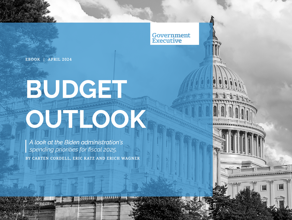OPM employees rely on cost advantage to win job competition
An obscure legislative provision helped 21 employees at the Office of Personnel Management win a public-private job competition last week.
A competitive sourcing provision in the fiscal 2004 omnibus appropriations act helped 21 employees at the Office of Personnel Management hold on to their jobs in a public-private contest completed last week.
Agencies covered under the Transportation-Treasury portion of the omnibus spending package, enacted in January, must allow in-house teams to submit bids in all public-private competitions involving more than 10 jobs. Those agencies, including OPM, must also "consider cost as one factor" in awarding work in streamlined competitions, where 10 to 65 positions are at stake.
The omnibus provision recommends that Transportation-Treasury agencies "consider" costs by granting in-house teams a 10 percent or $10 million cost advantage. In keeping with that language, OPM officials allowed 21 billing and collections employees to keep their positions, said Ron Flom, a senior procurement executive at the personnel agency.
Taking a 10 percent cost differential into account, the 21 federal employees demonstrated that over 5 years, they could save OPM $147,041 over the typical private contractor offering comparable services. Without the 10 percent advantage, the OPM workers would have lost that contest, he said. The competition was conducted under the Office of Management and Budget's May 2003 version of Circular A-76.
Contractors could have performed the work for about $400,000 less over the five years, but a $546,943 cost advantage pushed the federal employees over the edge, Flom said. OPM workers won two other streamlined competitions last week, but not by such a close margin.
In the other streamlined contests, 43 employees providing administrative accounting services and 29 trust fund accountants prevailed, Flom said. These groups showed that over five years, they would cost $11.5 million and $5.3 million less than a typical contractor, respectively.
OPM officials let in-house workers form "most efficient organizations" in all three contests completed last week, as required by the omnibus. For each case, the most efficient organization included all the employees currently performing the work. "In all these competitions, we thought we had the right numbers [of workers] at the right grades, and therefore we were competitive," Flom said. "This process reinforced that."
So far, federal workers have prevailed in every contest at OPM, retaining 384 jobs. The personnel agency is running one more streamlined competition involving computer and building management assistants in Macon, Ga. By August, the agency expects to announce the results of a larger competition involving 163 full-time clerical, technical and administrative support positions.
No matter who wins, job contests, "when done fairly," help agencies operate more efficiently, said OPM Director Kay Coles James in a statement announcing the latest results. "Competition drives excellence, and Team OPM is intensely competitive," she said.
But the Professional Services Association, an Arlington, Va.-based contractors association, has decided to take a closer look at how agencies are running streamlined job contests. Leaders of the group are concerned that in streamlined competitions, the playing field is tilted in favor of federal employees.
The association is gathering documents on how agencies have arrived at decisions to keep work in house, and will see if officials properly estimated the costs of contracting out work, said Stan Soloway, the group's president. The association will check whether agencies are "comparing apples to apples," said Alan Chvotkin, the council's senior vice president.
Soloway and Chvotkin are not singling out OPM for the review, but are looking into smaller contests at all agencies. Cost comparison documents have been hard to come by, Soloway said, adding that he would favor more transparency in the process.
OPM has fielded a number of inquiries on its cost estimates for streamlined competitions, Flom said, and is happy to answer most questions.
John Zottoli, president of American Federation of Government Employees Local 32, the union branch representing OPM employees, said he has had access to all the documents he needs, but would not mind if they are public. "In my mind, OPM is doing a competent job of running the competitions," he said. "I'm questioning the judgment to have them at all, but I think OPM has followed the regulations."
Cathy Garman, vice president for public policy at the Contract Services Association, said she also would like more transparency in streamlined contests. But she added that in some cases, the deck is simply stacked against contractors, especially those running small businesses. For instance, the 10 percent cost advantage granted in-house teams works to the detriment of small private companies.



